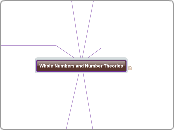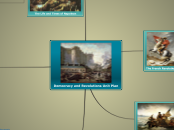Whole Numbers and Number Theories
This mind map is designed to help students learn about whole numbers and theories associated with numbers. Each subsection is either a process one can do with numbers such as addition or subraction, or a theory of numbers such as number systems or factorization.
Factors and Multiples
A factor is any number that divides another whole number
For example:
24/3---> 3 is a factor of 24, 8 is also a factor of 24.
A multiple is a number that a certain number goes into.
For example: Multiples of 2 are 4, 6, 8, 10, 12, 14, 16, 18 etc:
Least Common Multiple
The Least Common Multiple (LCM) is the smallest shared multiple between a set of two numbers.
Ex:
What is the LCM for 6 and 9?
6) 6, 12, 18, 24, 30, 36, 42, 48, 54
9) 9, 18, 27, 36, 45, 54, 63, 72, 81
the LCM(6,9) is 18 because 18 is the smallest number that each set has.
Greatest Common Factor
The Greatest Common Factor (GCF) is the biggest number that is a factor for a set of two numbers.
Ex:
Find the GCF for 24 and 36
24) 1, 2, 3, 4, 6, 8, 12, 24
36) 1, 2, 3, 4, 6, 9, 12, 18, 36
In this instance the GCF(24, 36) is 12. It is the biggest factor that they both share.
Divisitbility Tests
Divisibility Tests are designed to make division simpler. Some divisibity tests are easy to remember, like any number that has a last digit that is even is divisible by 2. Some are harder, like the divisibility rule for 11. The website attached explains the divisibility rules in an easy to understand format.
Prime or Composite
A prime number is a number that can only be divided by itself and 1
ex: 5 can only divided by 1 or 5
A Composite number is any number that is not prime
(can be divided by more than just itself and 1)
ex: 12 can be divided by 1,2,3,4,6, and 12.
Mulitiplication
Multiplication is often referred to as "Repeated Addition"
for this reason:
Any two whole numbers, a and b, the product of these two numbers is the sum of b recurring a times
a*b=b+b+b+b.... a times
Lattice Method
U.S Shorthand Method
Partial Product Method
Expanded Method
Rectangle Method
Addition
Addition uses algortihms to solve the problem. Algorithms involve adding the numbers, and carrying place values over to the next place value
There are many algorithms for addition. There is one called the "Stick method", "Partial Sums method" and the standard "U.S method"
Commutative Property for Addition
When any two numbers are added, the numbers may be moved around without any change to their sum;
a+b=b+a
Associative Property for Addition
For any whole numbers a, b, and c
a+(b+c)=(a+b)+c
this means that the middle number may be added to either of the other two numbers first, and the answer will not change.
Identitiy Property for Addition
For any number a,
a+0=a=0+a=a
0 makes no change when added to a number. 0 is the only identity number for addition.
Closure Property of Addition
For any numbers in a given set, if their sum is also a number in the set, the set is closed. If their sum is a number not in the set, the set is open.
Ex: {0,1}
1+0=1
0+0=0
1+1=2
this is not a closed set. 2 is not in the original set.
Division
Division is the opposite of Multiplication. For any two whole numbers a and b, b not equal to zero, the quotient of a/b, the whole number is c, such that a=c*b
We need to know multiplicatio in order to do division.
Sharing Concept
This concept determines the answer by making as many even groups as possible, as determined by the divisor.
For example:
18/3
Set up three groups. How many will be in each group?
There will be 6 units in each group.
Measurment Concept
Determine the answer by measuring off as many groups of the divisor as possible.
For example:
18/3
Measure off as many sets of 3 as possible
There will 6 groups of three units each.
Subtraction
Subtraction is the opposite of addition. Subtraction means taking away one number from another number. Subtraction also uses algorithms to do the process.
Missing Addend Concept
The Missing Addend Concept uses this logic:
If Ashley has 16 stickers, and she needs 20, how many more does she need?
In this case, we start counting from 16 to 20 to find the missing number, and what we get is the difference between the two.
Comparison Concept
The comparison concept uses this logic:
If Mary has 13 stickers, and Jon has 7, how many more does Mary have than Jon?
It this concept, we compare the two sets to find the difference.
The answer is 6 more stickers.
Take-Away Concept
The take-away concept uses this logic:
If Nancy has 13 stickers and she gives 5 away, how many does she have left?
This shows 5 things being taken away from 13 things.
The answer is 8 stickers left.
Number Systems
Base 12
Base 12
Positional Numbers
Numbers 0-11 are present
T stands for ten and E stands for eleven
Place values are 1, 12, 144, 1728, etc
Mayan
Modifed Base 20
Positional Numbers
**Number is written vertically instead of horizontally
Symbols represent numbers 0-19
Place values are 1, 20, (18*20), (18*20^2) etc
1 is on the bottom with 20 on top of that, and (18*20) on top of that
Base 5
Base 5
Positional numbers
Numbers 0,1,2,3,4 are represented
Place Values are 1, 5, 25, 125, 625 etc
Babylonian
Base 60
Positional numbers
Numbers 1-59 are represented
***0's do not exist in this system.
Numbers are made up of only two symbols.
Place Values are 1, 60, 3600, 21600 etc:
Decimal
Base 10
Positional--> the numbers can only be in one place, otherwise, the number changes
ex: 234 is not the same as 423
Numbers represented are 0,1,2,3,4,5,6,7,8 and 9
Place values are 1, 10, 100, 1000, 10000 etc:
Egyptian
Base 10
Non-Positional--> the symbols can be in any order, and the number would still be the same!
Symbols represent numbers
Place values are not present









